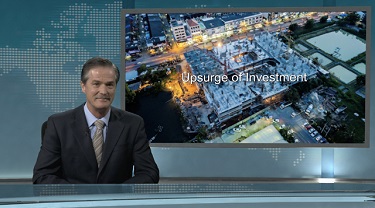If consumption is the economy’s Goliath, then investment is likely its David: that small but mighty element that time and again comes to our economic rescue, and creates wonderful tomorrows. For all its importance, David often takes a back seat to the headline-grabbing Goliath. Just how is investment doing these days? Do we have good reasons to be upbeat about its near-term prospects?
Before answering, a quick primer on the critical role investment in physical assets plays. At best, consumption gives us great todays. It keeps us going, for now. In contrast, investment is all about future goods and services. It creates the capacity to produce the stuff of tomorrow’s needs. In any economy, the sum of all investments, both past and present, is a great gauge of an economy’s ability – or lack of ability – to perform in the future. In fact, the stock of capital in any economy is one of three critical pillars of that economy’s calculated potential. As such, it is critical to know how current investment is building on that capital stock.
The news isn’t great. Truth be told, the entire planet has done a sketchy job of investing over the past eight years. That might not seem like a long time in the grand scheme of things, but when it comes to investment, in the minds of many, it’s an eternity. Back in the early 1970s investment across the developed world averaged annual inflation-adjusted growth of over 6 per cent. In the late 1970s, it slid to 5 per cent, maintaining that pace through the 1980s. In the 1990s, the average was 4 per cent, and it slid to 3.5 per cent in the 2003-07 phase. Post-recession investment growth hit a new low, averaging just 2.9 per cent annually. Exclude the public stimulus years, and growth averaged just 2.6 per cent. Yikes!
Purists would counter that the economy probably didn’t need any more investment; if so, businesses would have seen the opportunity, and simply done more. If that’s so, then it’s strange to see that after an extended period of relatively weak overall growth, OECD economies are currently faced with tight capacity constraints. Current capacity utilization is about as tight as it ever gets in both the US and Europe.
Have we collectively under-invested? It seems so; but why? Globally, we over-invested at the end of the last cycle, in order to keep up with a protracted bubble of excess consumption. Globalization exported this bubble everywhere, and when it burst, our initial, necessary under-investment lasted so long it became a habit. What it has failed to do is accurately predict the tipping point when demand would once again require a return to more normal investment growth. In that sense, our current capacity constraints are self-imposed; we have the capacity to create additional capacity, but we are bound in a low-growth mindset that market signals are trying to jolt us out of. Nascent trends suggest it’s working, but only time will tell.
Are rising interest rates the spoiler? Indeed, there is a negative relationship between financing costs and investment. But there are at least three mitigating factors.
- Interest rates have been ultra-low for ultra-long, and while the shift in this regime will require adjustment, rates will still on average compare favourably with historical averages.
- Rates will ultimately rise everywhere, increasing financing costs uniformly across most of the developed world.
- Investment is now accelerating in spite of interest rate increases, leading us to wonder what the ramp up might look like if rates had remained static.
Emerging markets have their own unique investment story to tell. Larger emerging economies filled the post-recession investment void with massive public stimulus programs, which in certain key cases, notably China, created vast surplus capacity. Other markets took advantage of far lower financing costs to undertake ambitious investment projects. Rising activity in the developed world is now helping to sop up this surplus, and we expect a concurrent return of private investment as a driving force in the emerging world over the medium term.
For years, investment has been small, and not so mighty. It seems to be rediscovering its strength, and if current momentum continues, it will increase the capacity to grow for many tomorrrows.





